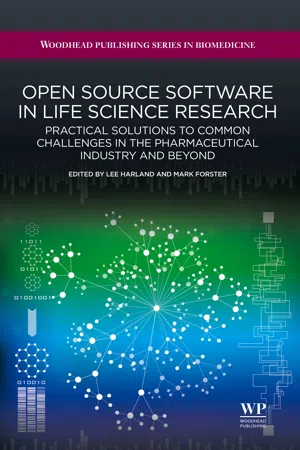
Open Source Software in Life Science Research
Practical Solutions to Common Challenges in the Pharmaceutical Industry and Beyond
- 582 pages
- English
- ePUB (mobile friendly)
- Available on iOS & Android
Open Source Software in Life Science Research
Practical Solutions to Common Challenges in the Pharmaceutical Industry and Beyond
About this book
The free/open source approach has grown from a minor activity to become a significant producer of robust, task-orientated software for a wide variety of situations and applications. To life science informatics groups, these systems present an appealing proposition - high quality software at a very attractive price. Open source software in life science research considers how industry and applied research groups have embraced these resources, discussing practical implementations that address real-world business problems.The book is divided into four parts. Part one looks at laboratory data management and chemical informatics, covering software such as Bioclipse, OpenTox, ImageJ and KNIME. In part two, the focus turns to genomics and bioinformatics tools, with chapters examining GenomicsTools and EBI Atlas software, as well as the practicalities of setting up an 'omics' platform and managing large volumes of data. Chapters in part three examine information and knowledge management, covering a range of topics including software for web-based collaboration, open source search and visualisation technologies for scientific business applications, and specific software such as DesignTracker and Utopia Documents. Part four looks at semantic technologies such as Semantic MediaWiki, TripleMap and Chem2Bio2RDF, before part five examines clinical analytics, and validation and regulatory compliance of free/open source software. Finally, the book concludes by looking at future perspectives and the economics and free/open source software in industry.- Discusses a broad range of applications from a variety of sectors- Provides a unique perspective on work normally performed behind closed doors- Highlights the criteria used to compare and assess different approaches to solving problems
Frequently asked questions
- Essential is ideal for learners and professionals who enjoy exploring a wide range of subjects. Access the Essential Library with 800,000+ trusted titles and best-sellers across business, personal growth, and the humanities. Includes unlimited reading time and Standard Read Aloud voice.
- Complete: Perfect for advanced learners and researchers needing full, unrestricted access. Unlock 1.4M+ books across hundreds of subjects, including academic and specialized titles. The Complete Plan also includes advanced features like Premium Read Aloud and Research Assistant.
Please note we cannot support devices running on iOS 13 and Android 7 or earlier. Learn more about using the app.
Information
Building research data handling systems with open source tools
Abstract:
1.1 Introduction
1.2 Legacy
Table of contents
- Cover image
- Title page
- Table of Contents
- Copyright
- Dedication
- List of figures and tables
- Foreword
- About the editors
- About the contributors
- Introduction
- Chapter 1: Building research data handling systems with open source tools
- Chapter 2: Interactive predictive toxicology with Bioclipse and OpenTox
- Chapter 3: Utilizing open source software to facilitate communication of chemistry at RSC
- Chapter 4: Open source software for mass spectrometry and metabolomics
- Chapter 5: Open source software for image processing and analysis: picture this with ImageJ
- Chapter 6: Integrated data analysis with KNIME
- Chapter 7: Investigation-Study-Assay, a toolkit for standardizing data capture and sharing
- Chapter 8: GenomicTools: an open source platform for developing high-throughput analytics in genomics
- Chapter 9: Creating an in-house ’omics data portal using EBI Atlas software
- Chapter 10: Setting up an ’omics platform in a small biotech
- Chapter 11: Squeezing big data into a small organisation
- Chapter 12: Design Tracker: an easy to use and flexible hypothesis tracking system to aid project team working
- Chapter 13: Free and open source software for web-based collaboration
- Chapter 14: Developing scientific business applications using open source search and visualisation technologies
- Chapter 15: Utopia Documents: transforming how industrial scientists interact with the scientific literature
- Chapter 16: Semantic MediaWiki in applied life science and industry: building an Enterprise Encyclopaedia
- Chapter 17: Building disease and target knowledge with Semantic MediaWiki
- Chapter 18: Chem2Bio2RDF: a semantic resource for systems chemical biology and drug discovery
- Chapter 19: TripleMap: a web-based semantic knowledge discovery and collaboration application for biomedical research
- Chapter 20: Extreme scale clinical analytics with open source software
- Chapter 21: Validation and regulatory compliance of free/open source software
- Chapter 22: The economics of free/open source software in industry
- Index